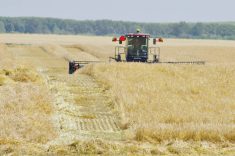Expanding crop insurance coverage is just one of the changes for crop insurance in 2013 and 2014. Here are some others.
Dollar selections per acre have increased to the following: All crops (excluding potatoes, vegetables and strawberries) $120, $160 and $200. For potatoes, the levels are $250, $500 and $750 and for vegetables and strawberries, they are $1,000, $1,500 and $2,000.
Hail Insurance is now available for all insurable crops regardless of whether the crop is selected for AgriInsurance. Farmers still must have an AgriInsurance contract to qualify for Manitoba Agricultural Services Corporation hail insurance.
Read Also

Manitoba sclerotinia picture mixed for 2025
Variations in weather and crop development in this year’s Manitoba canola fields make blanket sclerotinia outlooks hard to pin down
Aerial-seeded crops are no longer eligible for insurance. Broadcast seeding by ground is eligible, provided crop establishment is equal to or greater than the insured farmer’s coverage.
Part of the problem with aerial-seeded crop is that it’s difficult to distinguish it from a volunteer crop, said Craig Thomson, vice-president of insurance operations for the Manitoba Agricultural Services Corporation.
Variety restrictions on lentils end in 2013.
Open-pollinated corn (OPC) used for silage is now insurable as silage corn. OPC silage has a lower probable yield than hybrid corn silage. If an insured farmer grows both OPC and hybrid corn silage, the same coverage level must be selected for both types and all production will be combined for purpose of determining a claim.
The program is being expanded in the Dauphin and Neepawa agencies to test the concept and gauge producer demand.
Overseeding of damaged forage crops now qualifies for the Forage Restoration Benefit. For both Forage Establishment Insurance and the Forage Restoration Benefit, if an insured producer overseeds a damaged forage crop, the indemnity level is 50 per cent of coverage, with the remaining coverage continuing until the earlier of the destruction of the failed overseeded crop or June 25 of the following year. The deadline for filing a Forage Restoration claim is Sept. 30, with late claims, subject to a late fee, being accepted until Oct. 15.
MASC will continue to insure all winter wheat varieties under one program for 2013 whether they are in the Canadian Western Red Winter or Canadian Western General Purpose class.
Starting in the 2014 insurance year for crops seeded in the fall of 2013, MASC will no longer offer a Stage 1 (from the time of seeding until June 20) indemnity of 50 per cent of coverage for winter wheat and fall rye. Farmers will continue to be eligible for a reseeding benefit of 25 per cent of coverage if these crops are damaged before June 20 and need to be reseeded.
For 2013, the fall rye and winter wheat that is already seeded will continue to qualify for a Stage 1 indemnity.
Starting with the 2014 crop year the deadline for selecting the Excess Moisture Insurance (EMI) Reduced Deductible Option and EMI Higher Dollar Value Options is November 30, of the previous crop year.
Also starting in 2014, land must be added to an insurance contract by March 31 to be eligible for EMI coverage in that year. Land added after March 31 will continue to be eligible for coverage for seeded crops and hail, but not EMI.
Thomson stressed for the 2013 crop year, the deadline for selecting EMI options remains March 31, with land that is added until June 30 continuing to qualify for EMI.
Farmers will continue to be automatically covered under EMI at the base level.



















